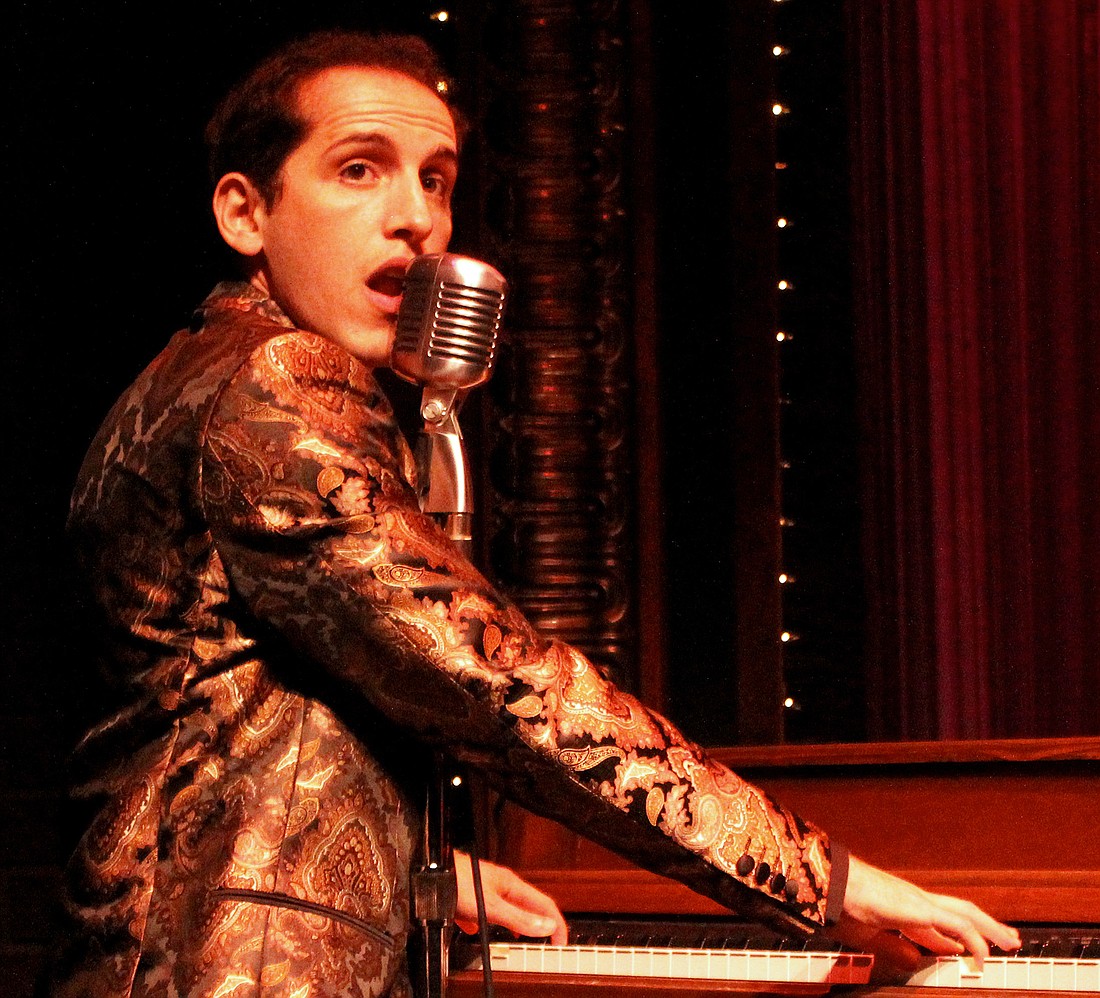- April 9, 2025
-
-
Loading

Loading

Jimi Hendrix torched his guitar at the Monterey Pop Festival in 1967. Cool pyrotechnics, but not entirely original.
Jerry Lee Lewis had incinerated an entire piano at Alan Freed’s Big Beat Show at the Brooklyn Paramount in 1958. The motive? Pure spite. By contract, Chuck Berry closed the show after Lewis’ penultimate act. Lewis decided to upstage him. A match and a Coke bottle filled with gasoline did the trick. “I want to see you follow that, Chuck.” Berry didn’t even try.
“Great Balls of Fire” captures a host of such musical moments in Lewis’ incendiary career on the FST cabaret stage. This revue is the brainchild of Jason Cohen (the lead performer) and Michael Schiralli. Cohen first began channeling Lewis during the national tour of “Million Dollar Quartet”—a tribute to the legendary day when Johnny Cash, Jerry Lee Lewis, Carl Perkins and Elvis all wound up together in the Sun Records recording studio. After the “Million Dollar” tour terminated, Cohen dropped the Jerry Lee Lewis character. But he didn’t feel like dropping Lewis’ music. That led to a gutsy creative decision.
Simply put, Cohen stopped bleaching his hair blond. He’d go back on tour — and keep banging out the Killer’s hits in a new, original revue called “Great Balls of Fire.” But he’d do it as himself, and not in the Jerry Lee Lewis persona. Peroxide would be the commercial, exploitive, sell-out, inauthentic, easy, smart choice. Authenticity was the right choice. Bravo.
Cohen’s touring band is comprised of Justin Brown (sax), Luke Darnell (lead guitar), Nathan Yates Douglass (double bass) and Jon Rossi (drums). These talented musicians all play multiple instruments and sing as well, but that gives you a general idea.
The revue kicks off with “Good Golly Miss Molly” — Little Richard’s 1956 hit and the first of many double entendres. Cohen follows it up with “Shake Rattle and Roll” — Bill Haley’s smash from 1954. (Here, the double meaning refers to throwing dice, if Wikipedia is not a liar.) Cohen delivers a killer rendition of “Money (That's What I Want)” — Janie Bradford and Berry Gordy’s R&B classic from 1959, made famous by The Beatles in 1963. A medley of tunes from the Big Easy gives a nod to Lewis’ roots. He’s a proud, native son of Louisiana and it shows.
The second act opens with “Whole Lotta Shakin’ Going On” (1955) — the third double entendre, if my count is accurate. The revue taps into Lewis’ country roots with Hank Williams’ “I’m So Lonesome I Could Cry” (1949) and goes deeper with a medley of spiritual selections. Cohen and the band open their hymnbooks to “I’ll Fly Away,” “Will the Circle Be Unbroken,” and “I Shall Not Be Moved.” Yes, Lewis was raised in the old-time religion — though he gave his soul to rock and roll. In the 1950s, Jimmy Swaggart, Lewis’ double-first cousin, was a budding Pentecostal evangelist confined to tents and not TV. He crusaded against Lewis and other rockers for playing “the Devil’s music.” Lewis kept on playing, though he feared there’d be Hell to pay.
Lewis’ “High School Confidential” is a sweet as a malted milkshake. (The song takes on a cringe-worthy meaning, granted Lewis’ marriage to his 13-year-old cousin.) Cohen saves “Great Balls of Fire” for last. His performance is not only energetic — it’s downright athletic. The man jumps up on the pounds the keys upside-down, backwards, and every-which-way. When that gets old, he kicks out chords with one foot. Cohen doesn’t literally set the piano fire. Metaphorically, it’s toast.
Manic movement is the key to Lewis’ music. Cohen’s tribute plays in that key. That’s why it feels like the real deal.
Hyperactive children are repeatedly commanded to sit still. Some obey, and go on to lead lives of quiet desperation. Others disobey — and grow up to be rock stars. I’m confident Lewis was one of them. Cohen is definitely another.
This cabaret concert gives each of his bandmates a slice of the spotlight. Douglass lays down a funky, bluesy groove on the harmonica in Chuck Berry’s “No Particular Place to Go” (1958). Guitarist Darnell sizzles in the switchback turns of “Johnny B. Goode,” another Berry classic. Saxophonist Brown makes his instrument wail and moan on “Shake, Rattle and Roll” (1954). Drummer Rossi holds his own at the stage’s perimeter — and captures the aggressive beat of tunes like “Money (That’s What I Want)” (1959) and “Whole Lotta Shakin’ Goin’ On” (1957).
Great show. But what makes it a Jerry Lee Lewis show — especially when the lead performer isn’t pretending to be Jerry Lee Lewis?
It’s a question of style and substance. With Jerry Lee Lewis, style was substance. He was no singer-songwriter — but he made the songs his own. Not in the sense of respectful homage. More like the way a shoplifter makes off with a bottle of wine. In the process, Lewis set a good/bad example for the rule (and instrument) breaking musicians who followed in the ’60s. (I imagine The Who still blame him for all the gear they smashed on stage.)
Lewis’ style was never safe. (The actual human being wasn’t either.) But Cohen perfectly captures the man’s cocky flash and flair.
This review offers a sizzling tribute to the musical side of Lewis’ legacy and doesn’t dig into his various scandals. It’s all about the music. If you want to go behind the music, try VH-1. If you want to enjoy the show, come here. And expect no sermons.
Lewis was a damn fine pianist and an incendiary, rock-and-roll showman. Lewis was also a sinner. Unlike his televangelist cousin, he never claimed to be otherwise.